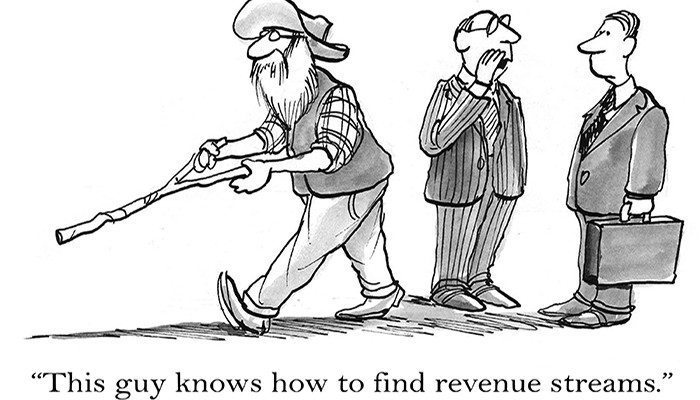Value and Price: Understanding the Forces that Influence Service Revenue
Apr 13, 2018 • Features • Management • Michael Blumberg • XaaS • Field Service Insights • IoT • selling service • Service Revenue • Smart Services
Michael Blumberg, President of Blumberg Associates and Founder of Field Service Insights offers us an in-depth look at how the key market forces that influence service revenues...
I am often asked by clients to help them implement strategies to grow their service revenue.
Often these engagements occur because a client perceives that they are not getting their fair share of revenue and it's impacting the profitability of their company.
Developing new revenue streams does not happen by magic, a consultant doesn’t just waive his wand and suddenly sales take off. Increasing top line service revenue takes a little work but the results of this effort can pay off handsomely.
All too often, Field Service management teams attempt to solve their revenue woes without first understanding their root cause.
They assume that the reason why more customers are not purchasing services from their company is that they price is too high. After all, that’s what their customers are telling them, so it must be true.

Companies that get caught up in this line of reasoning often find themselves implementing sales strategies based on some form of price concession, discount, or gimmick.
For example, charging the customer a small upfront contract fee for the right to purchase Time & Materials (T &M) service at a discounted rate, or treating service contracts as though they were a paid-up T & M retainer and allowing customers to carry unused portion of the retainer into the next year.
The assumption behind these pricing strategies is that more customers are likely to purchase the service because it is more affordable.
Unfortunately, the logic behind this line of reasoning is a bit flawed. Sure, the company may be able to secure more equipment under contracts through price adjustments. However, they will more than likely need to sell more service contracts to achieve the same gross margins as before the increase.
A company with a 40% Gross Margin target would need to generate an additional 35% in service revenue if they were to lower their prices by 10%.For example, a company with a 40% Gross Margin target would need to generate an additional 35% in service revenue if they were to lower their prices by 10%.
At issue, price may not necessarily be the only reason why companies don’t buy service. This assumption would hold true if all customers are price sensitive. The truth is all customers are not. It typically a small percentage.
More importantly, customers will always point to price as their primary reason for not buying services if they are not presented with other compelling reasons to buy.
The reason many customers do not purchase service is because of the perceived lack of value.
Customers think prices are too high when they do not recognise or understand the value they will receive from the service provided.
The problem is that it is difficult to articulate the value of service.
Most companies, particularly manufacturers, don’t know where to begin.
The more distinctions that can be made about a service, the more tangible it becomes, and the higher the probability that more customers will buy it.As consumers, we’ve all become accustomed to describing value in terms of the tangible aspects of a product. For example, its size, colour, workmanship, reliability and price. However, service is an intangible. How does one describe the value of something that is intangible?
The answer is by making distinctions about it. In other words, by describing the service in terms of the problems it solves, the outcomes or results it create, and/or the time it takes to complete.
Indeed, time is usually one of the biggest value drivers in field service.
Consider this, the more distinctions that can be made about a service, the more tangible it becomes, and the higher the probability that more customers will buy it.
Assuming no difference in price, which service offering sounds more appealing?
- A) a service contract that simply provides parts and labour or,
- B) one that provides 7-day by 24- hour coverage, parts, labor, same day onsite response time, remote support, and guaranteed uptime.
My hunch is that you picked B. This offering provides more value. Don’t you agree?
Unfortunately, most companies are not making these types of distinctions about their service offering.
It is should comes as no surprise that customers think the price is too high and don’t buy service contracts, and instead choose to take their chances and purchase service when needed on a Time & Materials basis.
Don’t misunderstand me, I am not urging field service companies to sell service features or outcomes they can’t deliver.
On the other hand, I am recommending those companies who are struggling with selling service contracts consider whether their service offerings or portfolios are defined with the customers' perception of value in mind.
For the service to have value, it must be described in terms of the experience or outcome provided.
Does it save time or money? Does it increase machine utilization? Does it improve the quality or cost of operations?
By defining the portfolio in this way, Field Service companies can test different offerings through competitive analysis, survey research, and conjoint (i.e., trade-off) analysis.
They would, of course, need to ensure they can deliver on the promise of the portfolio prior to offering it to the customers.
Conducting this type of research, also allows companies to determine which service offerings are most optimal or in demand by their customer base.
All things being equal, Customers will always choose the service offering the provides more value as defined by more distinctions In addition, distinctions provide the basis for differentiation and creating a competitive advantage. All things being equal, Customers will always choose the service offering the provides more value as defined by more distinctions then one that does not.
Some segments of the market may even pay a higher price for high value services particularly if they cannot purchase them elsewhere.
With the trend towards offering anything (e.g., products) as a service (XaaS) and Smart (i.e., IoT) Services, Field Service companies will need to become more adept at selling outcomes.
To do so they must be able to describe distinctions and articulate value. XaaS and Smart Services will not just sell themselves.
Field Service Executives are advised to start developing these skills now with service offered on existing equipment so they learn to be proficient at selling service contract when their XaaS and Smart Service programs are actually launched.
Be social and share





















 Field Service News is published by 1927 Media Ltd, an independent publisher whose sole focus is on the field service sector. As such our entire resources are focused on helping drive the field service sector forwards and aiming to best serve our industry through honest, incisive and innovative media coverage of the global field service sector.
Field Service News is published by 1927 Media Ltd, an independent publisher whose sole focus is on the field service sector. As such our entire resources are focused on helping drive the field service sector forwards and aiming to best serve our industry through honest, incisive and innovative media coverage of the global field service sector.
Leave a Reply